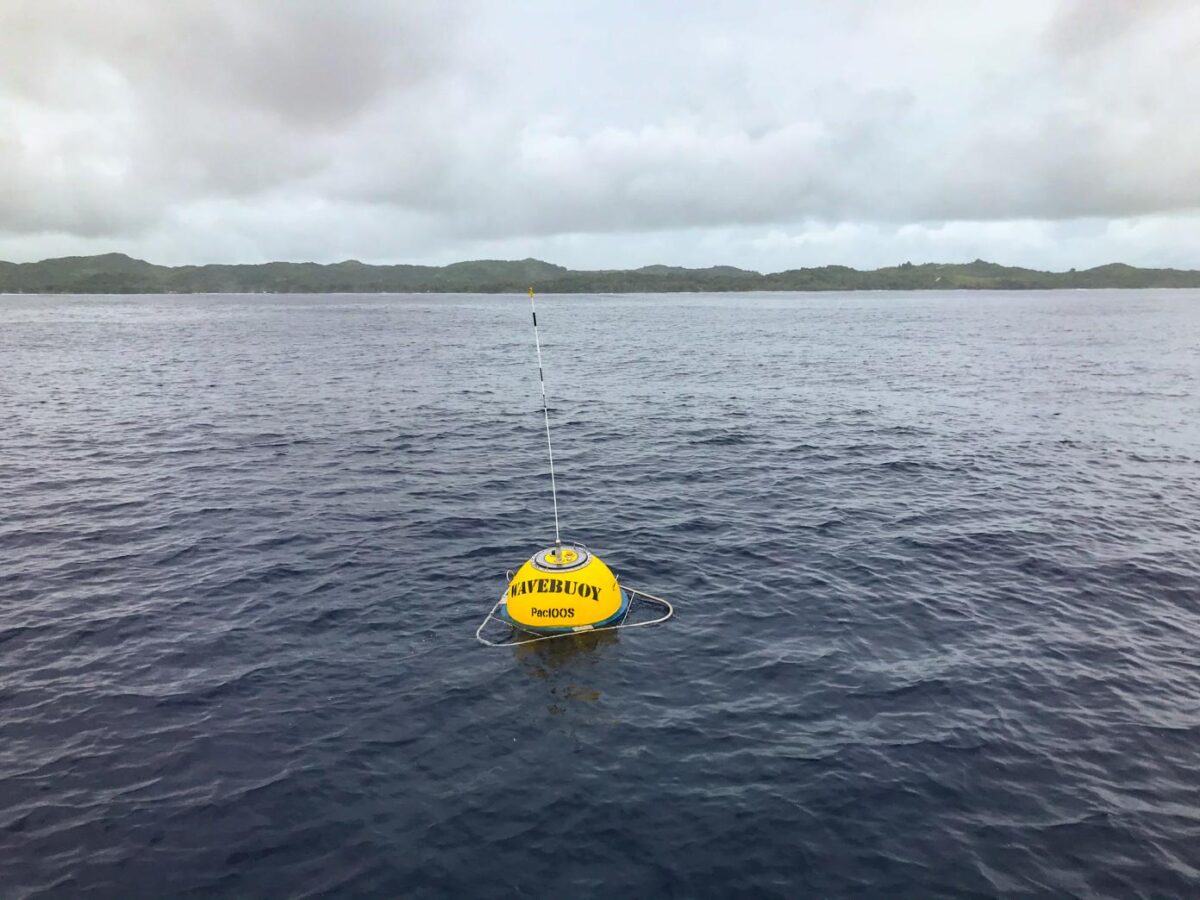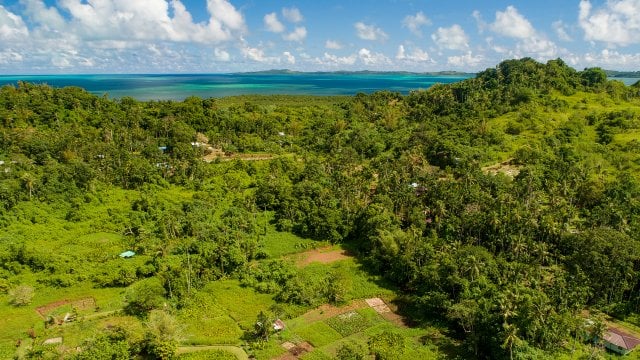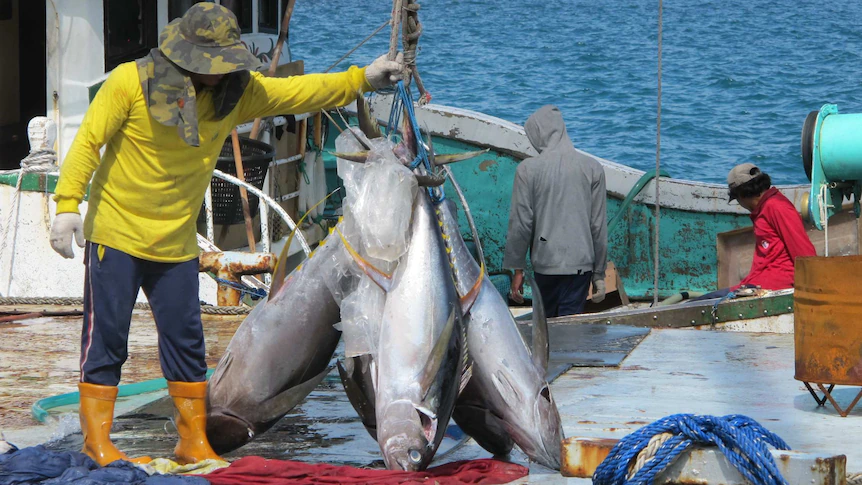Deployment of a new wave buoy to enhance disaster and climate resilience and monitor the conditions of the ocean in Palau
A new Wave rider buoy was recently deployed in Palau through international collaboration.
The data collected from the buoy — wave height, period and direction, surface current direction and speed, sea surface temperature, and air temperature — will enhance disaster and climate resilience in the Republic of Palau. This wave buoy, the only Waverider in the country, is located on the East side of the island of Babeldaob, about 1.4 miles offshore of Ngaraard State.
This effort is led by the Palau National Weather Service Office (NWSO) through the United Nations Development Programme (UNDP)’s Enhancing Disaster and Climate Resilience (EDCR) project and with the Pacific Islands Ocean Observing System (PacIOOS) based at the University of Hawai ‘i at Mānoa serving as the technical partner.
Palau experiences frequent natural hazards, and the impact of climate change and sea-level rise has also become one of the priority issues for Palau to address with a sense of urgency. Those extreme weather and climatic events often result in disruption of economic activity, and loss of people’s livelihoods.
In addition to being a central user of the data, Palau NWSO will have stewardship over the Waverider buoy to ensure its ongoing operations and maintenance. In addition, based on the experience gained from this project, Palau NWSO plans to expand the national wave buoy in the future with Green Climate Fund (GCF) support managed through the UN Environment Programme.
“Accurate and reliable wave and current data provide critical information to our weather forecasters, other agency officials, fishers, mariners and many other recreational and commercial ocean users to better understand prevailing ocean conditions and to make safe decisions,” said Maria Ngemaes, Meteorologist-in-Charge, Palau NWSO.
She added, “The new wave buoy will help us to validate and/or compare satellite and altimeter-derived information on the same variables that the buoy measures. It will also help us to monitor the conditions of the ocean in the event of severe weather and climate variability phenomenon, such as the extremes of ENSO: La Nina and El Nino, the Monsoon, Tropical Cyclones, Tropical Disturbances and shear lines that dip near and north of Palau, as well as sea level characteristics.”
PacIOOS will continue to provide technical support as needed in the coming years. In addition, the buoy will provide essential validation points for the future development of a high-resolution wave model for the island nation.
“PacIOOS strives to provide timely, reliable, and accurate ocean information to enhance safety and resilience,” explained Melissa Iwamoto, PacIOOS director.
“As such, we are honored to collaborate with Palau NWSO and all the partners on this effort, and we are dedicated to enhancing the capacity in Palau to maintain these valuable ocean instruments to serve user needs,” said Iwamoto.
Hagiwara Mayu, Chargé d’affaires ad interim, the Embassy of Japan in the Republic of Palau affirmed, “Disaster preparedness and management is one of the top priority areas of Japan’s continuous support to Palau. We hope that the first Waverider buoy deployed in Ngaraard State will contribute to improving the early warning system to protect the lives and livelihoods of the people in Palau by collecting and providing data to assess ocean conditions near their islands. We appreciate strong partnerships between Japan, the Government of Palau and UNDP as well as all institutions involved in this project.”
UNDP has placed strong emphasis and close coordination on working with relevant partners and the Palauan Government to ensure programmatic impact and presence for its efforts on resilient development.
“We highly appreciate all the partners that worked collaboratively to support Palau to increase their resilience to the disaster risk and the impact from climate change,” mentioned Levan Bouadze, Resident Representative of UNDP Pacific Office in Fiji.
The EDCR project, funded by the Government of Japan since its commencement in 2019, has provided equipment strategic to Palau’s disaster risk management. The project aims to strengthen disaster communication and climate monitoring systems; enhance national and state disaster responder’s readiness capacity, and enhance community disaster resilience through improved water resource management and integrated gender and social inclusion awareness.
PacIOOS currently also provides a six-day high sea-level forecast for Malakal, Palau. This is the first time PacIOOS has been a part of deploying and supporting a wave buoy in Palau.
While in Palau for the wave buoy deployment, PacIOOS wave buoy specialist Andreia Queima gave presentations to local agencies, organizations, and communities that are interested to learn more about the buoy, the data it provides and how to access and use the data. She also worked with the Palau NWSO team to implement protocols to maintain the wave buoy.
Additional partnerships with the Coastal Data Information Program (CDIP) in San Diego, CA and the Coral Reef Research Foundation (CRRF) on Malakal were integral to the successful deployment and data management. CRRF’s research vessel Kemedukl was used for buoy deployment and their bathymetric maps that supported the effort were funded by the U.S. Department of Interior Coral Reef/Natural Resources program and the U.S. National Science Foundation. PacIOOS involvement was also supported by funding provided by NOAA and the U.S. Department of State.
This story was originally published at UNDP on 13 June 2022, reposted via PACNEWS.




